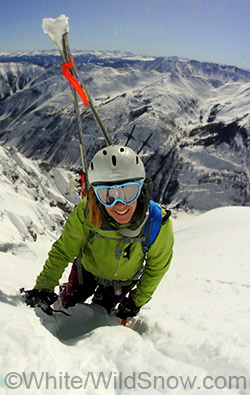
Brittany Walker backcountry skiing on Pyramid Peak, 2011
In other Colorado 14er skiing news, creativity is alive and well. Numerous descents are being made around the state, including a surprising but in the end logical way of getting off the summit of Pyramid Peak (near Aspen) by traversing west across a snowfield on the upper north face to the thread couloirs on the west side of the mountain. Al Beyer and Joey Giampaolo came up with that one. Congratulations! During good snow years, the west side is actually quite a fine ski descent. Myself and a friend had a nice day on that route back in the mid 1980s, when I was trying to figure out an alternative route due to poor snow coverage. During that trip it never occurred to me that one could drop east from the summit then move over to the west side, so we started our ski just below the summit bock. Very cool to see this sort of visionary stuff happening.
Well known professional skier Nick Devore has been in the news. He’s sharing thoughts about his recent avalanche accident, in which he broke his femur and underwent a lengthy and painful wait for a rescue. Femur breaks have something like a 50% mortality rate — in civilization — so Nick is lucky to be alive. I’ve been interested in how Nick would approach communicating about his accident. He appears to be honest and straightforward about the details, so anyone can learn a bit about avalanche safety by reading his accounts. But a somewhat disturbing takeaway from Nick’s words, in my view, is how accepting he appears to be of his fate.
“It’s what I do. I know the risks, and I’m willing to accept that this will probably happen again,” he says in an Aspen Times article (assuming he wasn’t misquoted).
I’m inspired or at least entertained by ski movie athletes such as Nick. At the same time I can’t help but think such a fatalistic approach to avalanche safety might be necessary for Nick during a certain time of his life, but would hopefully be the exception rather than the norm for almost any other ski mountaineer. (That said, I’m certain Nick’s feelings are more nuanced than a newspaper soundbite. Nonetheless, such a statement bears examination.)
If asked, here is how I’d place my avalanche safety philosophy in the space of a pine nut: “Master and enjoy the process of avoiding avalanches at all cost, and source your attitude out of respect for your body as well as concern for the loved ones your death or injury would impact.”
Yeah, I’ve screwed up a few times so who am I to say? Actually, I’d repeat what I say above, as that’s the lesson my own mistakes taught me.
Oh, one other thing from the broken bone club, Lou’s bone healing tips:No alcohol; extra vitamin C and calcium/magnesium tabs; lots of comedy movies and hanging out with friends and family; weight bearing only as much as the doc says; deep tissue work to break down huge amounts of scar tissue you get from a violent bone break such as that in an avalanche; cardio 5 or 6 days a week to keep oxygen level up (pool time, baby), but don’t overdo; healing prayers.
Moving along, I was grieved to hear about 33 year old Tucker Taffe dying in a crevasse fall on Mount Rainier. Tucker, of Alta in Utah, was another incredible mountain athlete who excelled on many levels. He’d clocked fast times in the Powderkeg randonnee race, and was known for hard and fast vertical in the human powered powder arena of the Wasatch. At the risk of sounding disrespectful (not intended), I’d offer that it’s incredibly important to break out the rope during travel on snow covered glaciers where there might be crevasses. While difficult for steeper downhill skiing on glaciers, going roped together on the uphill (as when Taffe was killed unroped) is quite easy and a good habit to inculcate. Some reports implied that Tucker’s party didn’t even have ropes (defunct links removed 2015), facts are they indeed did have rope but had chosen not to use it for the section of the climb where the accident happened. In any case, ropes are of course standard equipment for glacier climbing, but choosing when and where to use them is sometimes difficult and mistakes get made.
Wow, I’d better close on another positive note. So far, it appears this is the time for some of the best spring ski mountaineering in years. Colorado is huge. PNW is wet, scrappy as always and packed with white water crystals. And check out the Sierra, mind boggling snow accumulations. Everyone, enjoy!
And to continue with our positive take on the snowpack, dig this: Here in Colorado, one of our spring backcountry skiing meccas is Independence Pass east of Aspen. Nearly every year we try to informally organize a “Barbecue on the Pass” after it opens. This year well go for Saturday, June 4, or storm date on the next weekend, June 11. As always, we’ll get together on the “Upper Hairpin Turn” on the Aspen side of the Pass, starting at around 10:00 am. Bring your own portable BBQ cookers or cooler lunch, organize with friends. Tailgate or bring camp tables. The venue is right next to the road, but traffic is slow around the curve and lots of people stop in to visit. Plenty of skiing from parking if you get there in the early morning.
WildSnow.com publisher emeritus and founder Lou (Louis Dawson) has a 50+ years career in climbing, backcountry skiing and ski mountaineering. He was the first person in history to ski down all 54 Colorado 14,000-foot peaks, has authored numerous books about about backcountry skiing, and has skied from the summit of Denali in Alaska, North America’s highest mountain.
